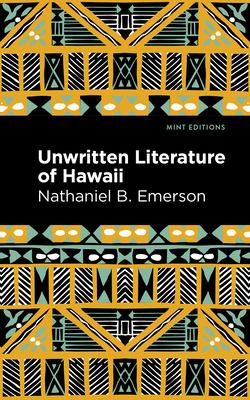Unwritten Literature of Hawaii: The Sacred Songs of the Hula (1909) is a collection of hulas and essays by Nathaniel B. Emerson. Translating previously unwritten songs, interviewing native Hawaiians, and consulting the works of indigenous historians, Emerson provides an entertaining and authoritative look at one of Hawaii's most cherished traditions. "For an account of the first hula we may look to the story of Pele. On one occasion that goddess begged her sisters to dance and sing before her, but they all excused themselves, saying they did not know the art. At that moment in came little Hiiaka, the youngest and the favorite. [...] When banteringly invited to dance, to the surprise of all, Hiiaka modestly complied. The wave-beaten sand-beach was her floor, the open air her hall; Feet and hands and swaying form kept time to her improvisation." As an American born in Hawaii who played a major role in the annexation of the islands as an author of the 1887 Constitution of the Hawaiian Kingdom, Emerson likely saw himself as a unifying figure capable of interpreting for an English-speaking audience the ancient and sacred tradition of the hula, a Polynesian dance often accompanied with instruments and chanting or singing. Combining critical analysis with samples of popular hulas in both Hawaiian and English, Emerson works to preserve part of the rich cultural heritage of the Hawaiian Islands. With a beautifully designed cover and professionally typeset manuscript, this edition of Nathaniel B. Emerson's Unwritten Literature of Hawaii: The Sacred Songs of the Hula is a classic of Hawaiian literature reimagined for modern readers.

Unwritten Literature of Hawaii: The Sacred Songs of the Hula
Unwritten Literature of Hawaii: The Sacred Songs of the Hula (1909) is a collection of hulas and essays by Nathaniel B. Emerson. Translating previously unwritten songs, interviewing native Hawaiians, and consulting the works of indigenous historians, Emerson provides an entertaining and authoritative look at one of Hawaii's most cherished traditions. "For an account of the first hula we may look to the story of Pele. On one occasion that goddess begged her sisters to dance and sing before her, but they all excused themselves, saying they did not know the art. At that moment in came little Hiiaka, the youngest and the favorite. [...] When banteringly invited to dance, to the surprise of all, Hiiaka modestly complied. The wave-beaten sand-beach was her floor, the open air her hall; Feet and hands and swaying form kept time to her improvisation." As an American born in Hawaii who played a major role in the annexation of the islands as an author of the 1887 Constitution of the Hawaiian Kingdom, Emerson likely saw himself as a unifying figure capable of interpreting for an English-speaking audience the ancient and sacred tradition of the hula, a Polynesian dance often accompanied with instruments and chanting or singing. Combining critical analysis with samples of popular hulas in both Hawaiian and English, Emerson works to preserve part of the rich cultural heritage of the Hawaiian Islands. With a beautifully designed cover and professionally typeset manuscript, this edition of Nathaniel B. Emerson's Unwritten Literature of Hawaii: The Sacred Songs of the Hula is a classic of Hawaiian literature reimagined for modern readers.